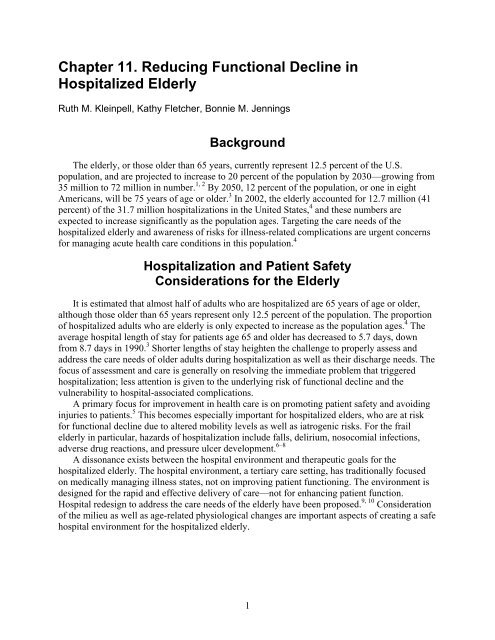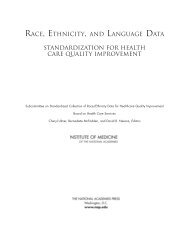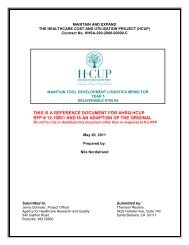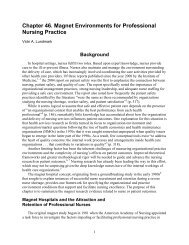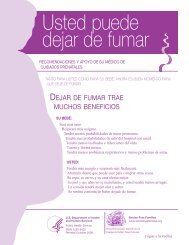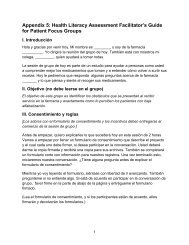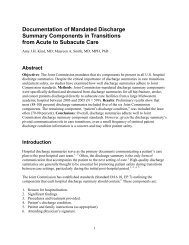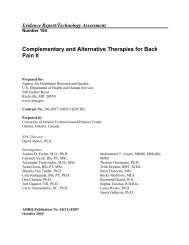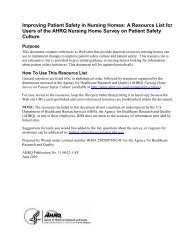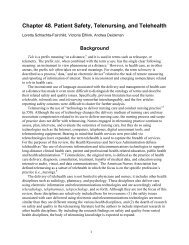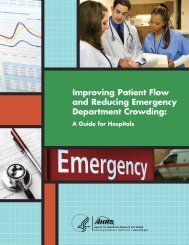Chapter 11. Reducing Functional Decline in Hospitalized Elderly
Chapter 11. Reducing Functional Decline in Hospitalized Elderly
Chapter 11. Reducing Functional Decline in Hospitalized Elderly
Create successful ePaper yourself
Turn your PDF publications into a flip-book with our unique Google optimized e-Paper software.
<strong>Chapter</strong> <strong>11.</strong> <strong>Reduc<strong>in</strong>g</strong> <strong>Functional</strong> <strong>Decl<strong>in</strong>e</strong> <strong>in</strong><br />
<strong>Hospitalized</strong> <strong>Elderly</strong><br />
Ruth M. Kle<strong>in</strong>pell, Kathy Fletcher, Bonnie M. Jenn<strong>in</strong>gs<br />
Background<br />
The elderly, or those older than 65 years, currently represent 12.5 percent of the U.S.<br />
population, and are projected to <strong>in</strong>crease to 20 percent of the population by 2030—grow<strong>in</strong>g from<br />
35 million to 72 million <strong>in</strong> number. 1, 2 By 2050, 12 percent of the population, or one <strong>in</strong> eight<br />
Americans, will be 75 years of age or older. 3 In 2002, the elderly accounted for 12.7 million (41<br />
percent) of the 31.7 million hospitalizations <strong>in</strong> the United States, 4 and these numbers are<br />
expected to <strong>in</strong>crease significantly as the population ages. Target<strong>in</strong>g the care needs of the<br />
hospitalized elderly and awareness of risks for illness-related complications are urgent concerns<br />
for manag<strong>in</strong>g acute health care conditions <strong>in</strong> this population. 4<br />
Hospitalization and Patient Safety<br />
Considerations for the <strong>Elderly</strong><br />
It is estimated that almost half of adults who are hospitalized are 65 years of age or older,<br />
although those older than 65 years represent only 12.5 percent of the population. The proportion<br />
of hospitalized adults who are elderly is only expected to <strong>in</strong>crease as the population ages. 4 The<br />
average hospital length of stay for patients age 65 and older has decreased to 5.7 days, down<br />
from 8.7 days <strong>in</strong> 1990. 3 Shorter lengths of stay heighten the challenge to properly assess and<br />
address the care needs of older adults dur<strong>in</strong>g hospitalization as well as their discharge needs. The<br />
focus of assessment and care is generally on resolv<strong>in</strong>g the immediate problem that triggered<br />
hospitalization; less attention is given to the underly<strong>in</strong>g risk of functional decl<strong>in</strong>e and the<br />
vulnerability to hospital-associated complications.<br />
A primary focus for improvement <strong>in</strong> health care is on promot<strong>in</strong>g patient safety and avoid<strong>in</strong>g<br />
<strong>in</strong>juries to patients. 5 This becomes especially important for hospitalized elders, who are at risk<br />
for functional decl<strong>in</strong>e due to altered mobility levels as well as iatrogenic risks. For the frail<br />
elderly <strong>in</strong> particular, hazards of hospitalization <strong>in</strong>clude falls, delirium, nosocomial <strong>in</strong>fections,<br />
adverse drug reactions, and pressure ulcer development. 6–8<br />
A dissonance exists between the hospital environment and therapeutic goals for the<br />
hospitalized elderly. The hospital environment, a tertiary care sett<strong>in</strong>g, has traditionally focused<br />
on medically manag<strong>in</strong>g illness states, not on improv<strong>in</strong>g patient function<strong>in</strong>g. The environment is<br />
designed for the rapid and effective delivery of care—not for enhanc<strong>in</strong>g patient function.<br />
Hospital redesign to address the care needs of the elderly have been proposed. 9, 10 Consideration<br />
of the milieu as well as age-related physiological changes are important aspects of creat<strong>in</strong>g a safe<br />
hospital environment for the hospitalized elderly.<br />
1
Patient Safety and Quality: An Evidence-Based Handbook for Nurses<br />
Age-Associated Changes<br />
A number of known physiological changes occur with ag<strong>in</strong>g, <strong>in</strong>clud<strong>in</strong>g reduced muscle<br />
strength and aerobic capacity, vasomotor <strong>in</strong>stability, baroreceptors <strong>in</strong>sensitivity and reduced total<br />
4, 11, 12<br />
body water, reduced bone density, reduced ventilation, and reduced sensory capacity.<br />
Comorbid conditions and chronic illness may heighten these changes. Muscle mass and muscle<br />
strength are reduced with ag<strong>in</strong>g and contribute to a reduction of physical activity. 12 With ag<strong>in</strong>g,<br />
alterations <strong>in</strong> autonomic function, <strong>in</strong>clud<strong>in</strong>g baroreceptor <strong>in</strong>sensitivity, occurs. Age-associated<br />
reduction <strong>in</strong> body water and plasma volume may predispose the elderly to syncope. Respiratory<br />
mechanics are also altered with ag<strong>in</strong>g, with reduced ventilation, <strong>in</strong>creased residual capacity, and<br />
reduced arterial oxygen tension. 12 Other age-associated changes <strong>in</strong>clude reduced bladder<br />
capacity and <strong>in</strong>creased ur<strong>in</strong>e production, prostrate enlargement, bone dem<strong>in</strong>eralization, loss of<br />
12, 13<br />
taste and smell, decreased sk<strong>in</strong> <strong>in</strong>tegrity, and reduction <strong>in</strong> sensory <strong>in</strong>put.<br />
As a result, the elderly are at higher risk for adverse physiological consequences dur<strong>in</strong>g acute<br />
illness, <strong>in</strong>clud<strong>in</strong>g impairment <strong>in</strong> functional status. Frailty—a state of musculoskeletal weakness<br />
and other secondary, widely distributed losses <strong>in</strong> structure and function—has been found to be<br />
attributed to decreased levels of activity and has been l<strong>in</strong>ked to the process of ag<strong>in</strong>g. 14 Advanced<br />
age, acute and chronic disease and illness, functional limitations, and decondition<strong>in</strong>g all<br />
contribute to the older adult’s vulnerability to functional decl<strong>in</strong>e dur<strong>in</strong>g hospitalization.<br />
<strong>Functional</strong> decl<strong>in</strong>e—the <strong>in</strong>ability to perform usual activities of daily liv<strong>in</strong>g due to weakness,<br />
reduced muscle strength, and reduced exercise capacity—occurs due to decondition<strong>in</strong>g and acute<br />
illness dur<strong>in</strong>g hospitalization. 15<br />
<strong>Functional</strong> Status<br />
<strong>Functional</strong> status is determ<strong>in</strong>ed by the ability to perform activities of daily liv<strong>in</strong>g (ADLs)—<br />
eat<strong>in</strong>g, dress<strong>in</strong>g, bath<strong>in</strong>g, ambulat<strong>in</strong>g, and toilet<strong>in</strong>g—and <strong>in</strong>strumental ADLs (IADLs)—<br />
shopp<strong>in</strong>g for groceries, meal preparation, housework, laundry, gett<strong>in</strong>g to places beyond walk<strong>in</strong>g<br />
distance, manag<strong>in</strong>g medications, manag<strong>in</strong>g f<strong>in</strong>ances, and us<strong>in</strong>g a telephone. 4 It is estimated that<br />
up to 8 percent of community-dwell<strong>in</strong>g elders need assistance with one or more ADLs. Among<br />
those age 85 and older, the percentage who live at home but need assistance or who live <strong>in</strong> a<br />
nurs<strong>in</strong>g home <strong>in</strong>creases significantly to 56 percent of women and 38 percent of men. 4 Chronic<br />
illness and comorbidities can directly impact functional status <strong>in</strong> the elderly. Chronic health care<br />
conditions that are most prevalent <strong>in</strong> the elderly <strong>in</strong>clude heart disease, hypertension, arthritis,<br />
diabetes, and cancer. 3 Acute illness due to chronic disease and chronic comorbidities accounts<br />
for a significant number of hospitalizations <strong>in</strong> the elderly.<br />
<strong>Functional</strong> <strong>Decl<strong>in</strong>e</strong> Dur<strong>in</strong>g Hospitalization<br />
Dur<strong>in</strong>g hospitalization, the elderly patient often experiences reduced mobility and activity<br />
levels. <strong>Functional</strong> decl<strong>in</strong>e, <strong>in</strong>clud<strong>in</strong>g changes <strong>in</strong> physical status and mobility, has been identified<br />
as the lead<strong>in</strong>g complication of hospitalization for the elderly. 16 The hazards of bed rest dur<strong>in</strong>g<br />
hospitalization are well established and <strong>in</strong>clude immobility, accelerated bone loss, dehydration,<br />
malnutrition, delirium, sensory deprivation, isolation, sheer<strong>in</strong>g forces on the sk<strong>in</strong>, and<br />
<strong>in</strong>cont<strong>in</strong>ence (see Table 1).<br />
12, 17<br />
Bed rest results <strong>in</strong> a reduction of exercise capacity due to several physiologic changes that<br />
occur, <strong>in</strong>clud<strong>in</strong>g reductions <strong>in</strong> maximal stroke volume, cardiac output, and oxygen uptake. 17 The<br />
2
<strong>Reduc<strong>in</strong>g</strong> <strong>Functional</strong> <strong>Decl<strong>in</strong>e</strong><br />
muscle fatigue that results is associated with reduced muscle blood flow, red cell volume,<br />
capillarization, and oxidative enzymes. 17 Accelerated bone loss can lead to a higher risk for<br />
<strong>in</strong>jury to bones and jo<strong>in</strong>ts, <strong>in</strong>clud<strong>in</strong>g hips and sp<strong>in</strong>e. 18<br />
Table 1. Effects of Bed Rest<br />
System Effect<br />
Cardiovascular ↓ Stroke volume, ↓ cardiac output, orthostatic hypotension<br />
Respiratory ↓ Respiratory excursion, ↓ oxygen uptake, ↑ potential for atelectasis<br />
Muscles ↓ Muscle strength, ↓ muscle blood flow<br />
Bone ↑ Bone loss, ↓ bone density<br />
GI Malnutrition, anorexia, constipation<br />
GU Incont<strong>in</strong>ence<br />
Sk<strong>in</strong> Sheer<strong>in</strong>g force, potential for sk<strong>in</strong> breakdown<br />
Psychological Social isolation, anxiety, depression, disorientation<br />
Sources: Amella EJ. Presentation of illness <strong>in</strong> older adults. Am J Nurs 2004;104:40-52. Creditor MC. Hazards of<br />
hospitalization of the elderly. Ann Intern Med 1993;118: 219-23. Convert<strong>in</strong>o VA. Cardiovascular consequences of bed<br />
rest: effect on maximal oxygen uptake. Med Sci Sports Exerc 1997;29:191-6.<br />
Decondition<strong>in</strong>g, which results <strong>in</strong> a decrease <strong>in</strong> muscle mass and the other physiologic<br />
changes related to bed rest, contributes to overall weakness. 19 <strong>Functional</strong> decl<strong>in</strong>e can then occur<br />
as a consequence of those physiologic changes and result <strong>in</strong> <strong>in</strong>ability to perform usual ADLs. 19<br />
Low levels of mobility and bed rest were common occurrences dur<strong>in</strong>g hospitalization for the<br />
elderly. 20 Decondition<strong>in</strong>g and functional decl<strong>in</strong>e from basel<strong>in</strong>e was found to occur by day 2 of<br />
hospitalization <strong>in</strong> elderly patients. 21 Loss of functional <strong>in</strong>dependence dur<strong>in</strong>g hospitalization<br />
resulted from not only the effects of acute illness, but also from the <strong>in</strong>ability to ma<strong>in</strong>ta<strong>in</strong> function<br />
dur<strong>in</strong>g hospitalization. 22 In assess<strong>in</strong>g physical activity of 500 hospitalized elderly patients, those<br />
who rema<strong>in</strong>ed <strong>in</strong> bed or who had chair activity rarely received physical therapy, had physician<br />
orders for exercises, or performed bedside strengthen<strong>in</strong>g exercises. 21 Comparisons of functional<br />
assessment at basel<strong>in</strong>e and day 2 of hospitalization <strong>in</strong> 71 patients over the age of 74 years<br />
demonstrated decl<strong>in</strong><strong>in</strong>g ability <strong>in</strong> mobility, transfer, toilet<strong>in</strong>g, feed<strong>in</strong>g, and groom<strong>in</strong>g. 23 Between<br />
day 2 and discharge, 67 percent demonstrated no improvement and 10 percent experienced<br />
further decl<strong>in</strong>e, highlight<strong>in</strong>g the potential for delayed functional recovery <strong>in</strong> the hospitalized<br />
elderly. 23 A followup of 489 hospitalized elders age 70 years and older revealed that the<br />
prevalence of lower mobility <strong>in</strong> hospitalized elderly was significant, with 16 percent<br />
experienc<strong>in</strong>g low levels of mobility, 32 percent experienc<strong>in</strong>g <strong>in</strong>termediate levels of mobility, and<br />
29 percent experienc<strong>in</strong>g a decl<strong>in</strong>e <strong>in</strong> an ADL activity. 20 Yet for almost 60 percent of bed-rest<br />
episodes, there was no documented medical <strong>in</strong>dication for limit<strong>in</strong>g mobility status.<br />
Preadmission health and functional status of the elderly can <strong>in</strong>dicate risk of further functional<br />
decl<strong>in</strong>e associated with hospitalization. In exam<strong>in</strong><strong>in</strong>g the basel<strong>in</strong>e functional status of 1,212<br />
hospitalized patients age 70 years and older, the use of ambulation assistive devices, such as<br />
canes and walkers, was predictive of functional decl<strong>in</strong>e associated with hospitalization. 24 Use of<br />
a walker was associated with a 2.8 times <strong>in</strong>creased risk for decl<strong>in</strong>e <strong>in</strong> ADL function by the time<br />
of hospital discharge (P = 0.0002). Moreover, 3 months after discharge, patients who had used<br />
an assistive device prior to hospitalization were more likely to have decl<strong>in</strong>ed <strong>in</strong> both ADL status<br />
(P = 0.02) and IADL status (P = 0.0003). 24 Other risk factors found to be predictive of<br />
3
Patient Safety and Quality: An Evidence-Based Handbook for Nurses<br />
functional decl<strong>in</strong>e <strong>in</strong> the elderly dur<strong>in</strong>g hospitalization <strong>in</strong>cluded hav<strong>in</strong>g two or more<br />
comorbidities, tak<strong>in</strong>g five or more prescription medications, and hav<strong>in</strong>g had a hospitalization or<br />
emergency room visit <strong>in</strong> the previous 12 months. 25<br />
Associations between functional status and other risk factors such as cognitive status must<br />
also be considered. Hospital-related complications or <strong>in</strong>adequate hospital care have been l<strong>in</strong>ked<br />
to the development of delirium <strong>in</strong> the hospitalized elderly. 26 Impairment <strong>in</strong> cognitive status was<br />
found to be associated with changes <strong>in</strong> functional status <strong>in</strong> the hospitalized elderly. A study of<br />
2,557 patients from two teach<strong>in</strong>g hospitals exam<strong>in</strong>ed the association between level of impaired<br />
performance on a cognitive status screen and ma<strong>in</strong>tenance and recovery of function<strong>in</strong>g from<br />
admission through 90 days after discharge. Performance on a brief cognitive screen on admission<br />
was strongly related to subsequent change <strong>in</strong> function. Among patients who needed help<br />
perform<strong>in</strong>g one or more ADLs at the time of admission, 23 percent of patients with moderate to<br />
severely impaired cognitive performance, 49 percent of patients with mildly impaired cognitive<br />
performance, and 67 percent of patients with little or no impairment <strong>in</strong> cognitive performance<br />
recovered the ability to <strong>in</strong>dependently execute an additional ADL by discharge (P < 0.001). 22<br />
Additional studies identified that prolonged recovery and cont<strong>in</strong>ued ADL limitations occurred<br />
after hospitalization. In follow<strong>in</strong>g 1,279 patients age 70 years and older after hospital discharge,<br />
a study found that 59 percent reported no change <strong>in</strong> ADL status, 10 percent reported<br />
improvement, and 39 percent reported decl<strong>in</strong>ed ADL status at discharge when compared to<br />
preadmission status. At 3 months after discharge, 40 percent reported a new ADL or IADL<br />
disability compared with preadmission, reflect<strong>in</strong>g the potential for cont<strong>in</strong>ued functional decl<strong>in</strong>e<br />
after hospitalization for acute illness. 27<br />
Yet, the loss of functional <strong>in</strong>dependence is not an <strong>in</strong>evitable consequence of hospitalization<br />
for the elderly. 28, 29 Evidence exists that targeted <strong>in</strong>terventions can impact the degree of<br />
functional <strong>in</strong>dependence for hospitalized elders. 30<br />
Research Evidence<br />
Targeted measures that have proven beneficial <strong>in</strong> mitigat<strong>in</strong>g functional decl<strong>in</strong>e dur<strong>in</strong>g<br />
hospitalization have <strong>in</strong>cluded comprehensive geriatric assessments to identify patients at risk,<br />
structured geriatric care models, dedicated hospital units for acute care of the elderly, and the use<br />
of specific resources to enhance care for the hospitalized elder.<br />
Comprehensive Geriatric Assessment<br />
Comprehensive geriatric assessment (CGA) is used to create a plan of care for hospitalized<br />
elders. A specific goal of the CGA is early identification of elder care needs <strong>in</strong> order to provide<br />
<strong>in</strong>terventions to m<strong>in</strong>imize high-risk events such as falls or the onset of delirium. 31<br />
A CGA should <strong>in</strong>clude assessment of ADL and IADL performance as well as assessment of<br />
cognition, vision and hear<strong>in</strong>g, social support, and psychological well-be<strong>in</strong>g. 19 A number of<br />
geriatric assessment tools can be used to make <strong>in</strong>itial and ongo<strong>in</strong>g evaluations of hospitalized<br />
elders. Commonly used tools <strong>in</strong>clude the Katz Index of Independence <strong>in</strong> Activities of Daily<br />
Liv<strong>in</strong>g, 32 the Lawton Instrumental Activities of Daily Liv<strong>in</strong>g Scale, 33 and the Hospital Admission<br />
Risk Profile (HARP), among others (see Table 2).<br />
4
Table 2. Commonly Used Geriatric Assessment Measures*<br />
<strong>Reduc<strong>in</strong>g</strong> <strong>Functional</strong> <strong>Decl<strong>in</strong>e</strong><br />
Instrument Areas of Assessment Reference<br />
SPICES Sleep, problems with eat<strong>in</strong>g or<br />
feed<strong>in</strong>g, <strong>in</strong>cont<strong>in</strong>ence,<br />
confusion, evidence of falls,<br />
sk<strong>in</strong> breakdown<br />
Geriatric Institutional Assessment Profile Hospital staff knowledge of<br />
geriatric care pr<strong>in</strong>ciples,<br />
organizational environment<br />
Fulmer 1991 59<br />
Wallace 1998 66<br />
Abraham 1999 41<br />
Hospital Admission Risk Profile (HARP) ADL, IADL, cognitive status Sager 1996 34<br />
Lawton Instrumental Activities Daily Liv<strong>in</strong>g Scale IADL activities: medication<br />
management, housekeep<strong>in</strong>g,<br />
food preparation,<br />
transportation, shopp<strong>in</strong>g,<br />
manag<strong>in</strong>g f<strong>in</strong>ances, laundry<br />
<strong>Functional</strong> Independence Measure (FIM) <strong>Functional</strong> status <strong>in</strong> 7 areas:<br />
self-care, locomotion,<br />
communication, social<br />
cognition, cooperation,<br />
problem-solv<strong>in</strong>g, sph<strong>in</strong>cter<br />
control<br />
Timed UP and Go Test Mobility, balance, gait, transfer<br />
ability, walk<strong>in</strong>g<br />
2 M<strong>in</strong>ute Walk Test Exercise tolerance and exercise<br />
capacity<br />
* For additional geriatric assessment resources, the Try This series can be found at<br />
www.hartfordign.org/resources/education/tryThis.html.<br />
Lawton 1969 33<br />
Kidd 1995 67<br />
Keith 1987 68<br />
Podsiadlo 1991 69<br />
Brooks 2001 70<br />
As part of CGA, basel<strong>in</strong>e admission assessments have proved beneficial <strong>in</strong> identify<strong>in</strong>g<br />
patients at risk for functional decl<strong>in</strong>e dur<strong>in</strong>g hospitalizations. The HARP was used <strong>in</strong> one study<br />
to assess preadmission risk factors among more than 800 patients age 70 years and older who<br />
were hospitalized for acute medical illness. 34 The HARP <strong>in</strong>cludes assessment of ADL status,<br />
IADL status, and cognitive status. Researchers found that three factors <strong>in</strong>dependently predict<br />
functional decl<strong>in</strong>e: <strong>in</strong>creas<strong>in</strong>g age, lower admission cognitive status, and lower preadmission<br />
IADL function. Patients at low risk of functional decl<strong>in</strong>e were more likely to recover ADL<br />
function and avoid nurs<strong>in</strong>g home placement at 3 months after discharge.<br />
Another functional status <strong>in</strong>strument that can be used to assess basel<strong>in</strong>e activity and<br />
functional levels is the Mobility Classification Tool, described by Callen and colleagues. 35 The<br />
tool may prove useful for nurses to assess, quantify, and communicate basel<strong>in</strong>e levels and<br />
changes <strong>in</strong> mobility. Basel<strong>in</strong>e assessments can provide useful <strong>in</strong>formation for structur<strong>in</strong>g care<br />
dur<strong>in</strong>g hospitalization and establish<strong>in</strong>g goals for the care.<br />
Aside from the use of formal assessment <strong>in</strong>struments that measure ADL and IADL function,<br />
a general idea of functional status can be ascerta<strong>in</strong>ed by assess<strong>in</strong>g mobility and activity<br />
performance dur<strong>in</strong>g hospitalization. The frequency of hallway ambulation <strong>in</strong> hospitalized elders<br />
was exam<strong>in</strong>ed <strong>in</strong> an observational study of 118 patients age 55 years and older <strong>in</strong> a s<strong>in</strong>gle<br />
sett<strong>in</strong>g. 36 While all patients were considered by their primary nurse as able to walk the hallways,<br />
5
Patient Safety and Quality: An Evidence-Based Handbook for Nurses<br />
72.9 percent did not walk at all per 3-hour period of observation, 18.6 percent walked once, 5.1<br />
percent twice, and only 3.4 percent walked more than twice. 35 The median time of ambulation<br />
was 5.5 m<strong>in</strong>utes. Of the 32 patients who walked <strong>in</strong> the hallways, 46.8 percent (n = 15) did so<br />
alone, 41 percent (n = 13) walked with a therapist, 41 percent (n = 13) walked with a member of<br />
the nurs<strong>in</strong>g staff, and 18.8 percent (n = 6) walked with a family member.<br />
Based on the results of the CGA, functional problems or potential problems are identified<br />
and specific <strong>in</strong>terventions can be implemented to promote functional ability <strong>in</strong> hospitalized<br />
elders. A number of <strong>in</strong>terventions, <strong>in</strong>clud<strong>in</strong>g structured exercise, progressive resistance strength<br />
tra<strong>in</strong><strong>in</strong>g, and walk<strong>in</strong>g programs, have been implemented to target elder care function<strong>in</strong>g dur<strong>in</strong>g<br />
hospitalization. 35, 37, 38 A randomized control trial of a hospital-based general exercise program<br />
with 300 hospitalized elders that was started dur<strong>in</strong>g hospitalization and cont<strong>in</strong>ued for 1 month<br />
after discharge did not affect length of stay, but did demonstrate better IADL function at 1 month<br />
after discharge. 38 Measures to improve endurance—<strong>in</strong>clud<strong>in</strong>g exercise to enhance orthostatic<br />
stability, daily endurance exercise to ma<strong>in</strong>ta<strong>in</strong> aerobic capacity, or specific resistance exercises to<br />
ma<strong>in</strong>ta<strong>in</strong> musculoskeletal <strong>in</strong>tegrity 17, 39, 40 —need further study on their impact <strong>in</strong> reduc<strong>in</strong>g<br />
functional decl<strong>in</strong>e <strong>in</strong> hospitalized elders. As hospital-based exercise programs require<br />
coord<strong>in</strong>ation and focused implementation plans, strategies for adopt<strong>in</strong>g them need to recognize<br />
the shortened length of hospital stay and the effects of acute illness on the patients’ ability to<br />
participate.<br />
In addition to utiliz<strong>in</strong>g tools to assess the elderly hospitalized patient, assessments of the<br />
hospital culture for provid<strong>in</strong>g elder care can also be beneficial. The Geriatric Institutional<br />
Assessment Profile was specifically developed to assess hospital workers’ knowledge, attitudes,<br />
and perceptions of car<strong>in</strong>g for elders, as well as the adequacy of the <strong>in</strong>stitutional environment to<br />
meet hospitalized elders’ needs. 41 It is recommended to help identify both the strengths <strong>in</strong> elder<br />
care and the opportunities for improvement. 42<br />
Structured Geriatric Care Models<br />
For more than 20 years, the concept of hospital-based geriatric assessment and<br />
<strong>in</strong>terdiscipl<strong>in</strong>ary team care to improve outcomes for hospitalized elders has been implemented <strong>in</strong><br />
various models. Early studies on the use of geriatric evaluation and geriatric evaluation units<br />
demonstrated an impact on reduc<strong>in</strong>g disability and nurs<strong>in</strong>g home placement. 43–45 Several<br />
hospital-based geriatric resource models of care have also demonstrated benefits <strong>in</strong> promot<strong>in</strong>g<br />
evidence-based care for hospitalized elders, <strong>in</strong>clud<strong>in</strong>g the use of geriatric <strong>in</strong>terdiscipl<strong>in</strong>ary team<br />
tra<strong>in</strong><strong>in</strong>g 46 and the use of a geriatric resource nurse. 47 National programs for geriatric<br />
<strong>in</strong>terdiscipl<strong>in</strong>ary team tra<strong>in</strong><strong>in</strong>g were created <strong>in</strong> 1997 to enhance the knowledge of car<strong>in</strong>g for<br />
elders among a variety of health professions. While evaluation data have demonstrated<br />
improvement of geriatric <strong>in</strong>terdiscipl<strong>in</strong>ary team tra<strong>in</strong>ees, most notably <strong>in</strong> attitud<strong>in</strong>al measures, 46<br />
further study on the impact on geriatric care plann<strong>in</strong>g is needed.<br />
Several focused models of care designed to prevent functional decl<strong>in</strong>e of the hospitalized<br />
elderly have demonstrated significant results. The Hospital <strong>Elderly</strong> Life Program, a structured<br />
screen<strong>in</strong>g program for hospitalized patients age 70 years and older, concentrates on admission<br />
screen<strong>in</strong>g of six risk factors: cognitive impairment, sleep deprivation, immobility, dehydration,<br />
vision loss, and hear<strong>in</strong>g impairment. 16 More than 1,500 patients were screened, and targeted<br />
<strong>in</strong>terventions based on the presence of admission risk factors were <strong>in</strong>stituted. Patients were<br />
followed by an <strong>in</strong>terdiscipl<strong>in</strong>ary team that <strong>in</strong>cluded a geriatric nurse specialist, <strong>Elderly</strong> Life<br />
specialists, and geriatricians who worked <strong>in</strong> conjunction with the patient’s primary care nurse to<br />
6
<strong>Reduc<strong>in</strong>g</strong> <strong>Functional</strong> <strong>Decl<strong>in</strong>e</strong><br />
formulate an <strong>in</strong>dividualized plan of care. Use of the program demonstrated significant results:<br />
only 14 percent of patients had a decl<strong>in</strong>e on ADL scores, compared to a decl<strong>in</strong>e <strong>in</strong> 33 percent of<br />
the control group.<br />
Acute Care for <strong>Elderly</strong> (ACE) units. Models of care <strong>in</strong>corporate a variety of <strong>in</strong>terventions<br />
to promote positive outcomes for the hospitalized elderly. Specific programs have also been<br />
tested on specialized units with<strong>in</strong> the hospital sett<strong>in</strong>g. These units, termed Acute Care for the<br />
<strong>Elderly</strong> (ACE units), provide dedicated care to the hospitalized elderly.<br />
Orig<strong>in</strong>at<strong>in</strong>g <strong>in</strong> the early 1990s, the ACE unit concept has been adopted by organizations as a<br />
strategy to provide care to elderly patients dur<strong>in</strong>g hospitalization. 48–49 ACE units promote a<br />
focused model of care that <strong>in</strong>tegrates geriatric assessment <strong>in</strong>to medical and nurs<strong>in</strong>g care of<br />
patients <strong>in</strong> an <strong>in</strong>terdiscipl<strong>in</strong>ary environment. 50 The focus is to provide expert care while<br />
simultaneously keep<strong>in</strong>g patients mobile and prevent<strong>in</strong>g the loss of normal daily rout<strong>in</strong>es. 49 ACE<br />
units <strong>in</strong>clude specially designed environmental changes to promote activity such as ambulation<br />
<strong>in</strong> hallways, exercise facilities, and social gather<strong>in</strong>g areas. 51 Multidiscipl<strong>in</strong>ary teams composed of<br />
geriatric physicians; nurses; dietician; social worker; pharmacist; and occupational, speech, and<br />
physical therapists regularly discuss the plan of care for each patient. 49 Major components of the<br />
ACE unit concept <strong>in</strong>clude patient-centered nurs<strong>in</strong>g care (daily assessment of functional needs by<br />
nurs<strong>in</strong>g, nurs<strong>in</strong>g-based protocols to improve outcomes, daily rounds by a multidiscipl<strong>in</strong>ary team),<br />
a prepared environment, plann<strong>in</strong>g for discharge, and medical care review.<br />
Another model, designed to improve functional outcomes of acutely ill hospitalized elders,<br />
was tested <strong>in</strong> a randomized control trial with 1,794 patients 70 years of age and older <strong>in</strong> one unit<br />
of a hospital. A number of <strong>in</strong>terventions were implemented under the direction of the primary<br />
nurse, <strong>in</strong>clud<strong>in</strong>g basel<strong>in</strong>e and ongo<strong>in</strong>g assessment of risk factors; follow<strong>in</strong>g protocols to improve<br />
self-care, cont<strong>in</strong>ence, nutrition, mobility, sleep, sk<strong>in</strong> care, and cognition; conduct<strong>in</strong>g daily rounds<br />
with a multidiscipl<strong>in</strong>ary team; and environmental enhancements such as handrails, uncluttered<br />
hallways, large clocks and calendars, elevated toilet seats, and door levers. 29 Results <strong>in</strong>dicated<br />
that 21 percent of <strong>in</strong>tervention patients were classified as much better <strong>in</strong> ADL activity abilities,<br />
13 percent as better, 50 percent as unchanged, 22 percent as worse, and 9 percent as much worse.<br />
In the control group, 13 percent were classified as much better, 11 percent as better, 54 percent<br />
as unchanged, 13 percent as worse, and 8 percent as much worse (P = 0.0009). While the<br />
program <strong>in</strong>terventions improved functional status <strong>in</strong> a significant percentage of the patients, the<br />
majority of the patients <strong>in</strong> both the <strong>in</strong>tervention and control groups were unchanged or worse at<br />
the time of discharge. At 3 months after discharge, the groups did not differ significantly <strong>in</strong> terms<br />
of ADL or IADL abilities. 29 The results of this study suggested that while targeted <strong>in</strong>terventions<br />
can improve functional <strong>in</strong>dependence <strong>in</strong> the hospitalized elderly, some patients will cont<strong>in</strong>ue to<br />
experience functional decl<strong>in</strong>e, despite focused <strong>in</strong>terventions.<br />
Research compar<strong>in</strong>g ACE units and standard medical care units has demonstrated positive<br />
outcomes, with improvements <strong>in</strong> ADL function and fewer transfers to nurs<strong>in</strong>g home sett<strong>in</strong>gs<br />
after discharge. 29 A randomized controlled study of 1,531 elders age 70 years and older<br />
demonstrated that use of an ACE unit improved processes of care and promoted patient and<br />
provider satisfaction without <strong>in</strong>creas<strong>in</strong>g hospital length of stay or costs. 51 Additional study on the<br />
cost effectiveness of ACE units has demonstrated significant reductions <strong>in</strong> average length of stay<br />
(0.8 day) and a cost sav<strong>in</strong>gs of $1,490 compared to control patients on two medical-surgical units,<br />
a sav<strong>in</strong>gs that translated to $1.3 million <strong>in</strong> 9 months 48 as well as no <strong>in</strong>crease <strong>in</strong> hospital costs. 53<br />
The NICHE model. An additional model focus<strong>in</strong>g on improv<strong>in</strong>g hospital care for the elderly,<br />
the Nurses Improv<strong>in</strong>g Care of Health System Elders (NICHE) project, was <strong>in</strong>itiated <strong>in</strong> the early<br />
7<br />
10, 52
Patient Safety and Quality: An Evidence-Based Handbook for Nurses<br />
1990s. The project is a national program focused on promot<strong>in</strong>g evidenced-based care for<br />
elders. 42, 54 Resources <strong>in</strong>clude best practice protocols, educational materials, nurs<strong>in</strong>g care models<br />
to replicate, and assessment tools. A unique series of onl<strong>in</strong>e assessment tools, Try This, is<br />
available at www.hartfordign.org/resources/education/tryThis.html. Assessments of the NICHE<br />
program <strong>in</strong>dicate that fewer patients were acutely confused at discharge, 55 restra<strong>in</strong>t use was<br />
reduced by more than 60 percent, serious <strong>in</strong>juries related to falls were reduced by 30 percent,<br />
there were beg<strong>in</strong>n<strong>in</strong>g signs of reduction <strong>in</strong> the <strong>in</strong>cidence of aspiration pneumonia and ur<strong>in</strong>ary<br />
tract <strong>in</strong>fection, and patient mobility equipment was standardized. 56 Outcome reports from<br />
implementation of NICHE also <strong>in</strong>cluded <strong>in</strong>creased nurs<strong>in</strong>g knowledge of geriatric care,<br />
decreased length of stay, and reduced costs. 42, 56–58 The NICHE model of care is currently a<br />
voluntary program, and while additional outcomes-based research is needed, implementation of<br />
the program components by all hospital sett<strong>in</strong>gs would facilitate best practices for elder care.<br />
The geriatric resource nurse model is the most widely used NICHE model. In the geriatric<br />
resource nurse model, unit-based nurses acquire competency <strong>in</strong> elder care and improve care by<br />
model<strong>in</strong>g best practices and provid<strong>in</strong>g consultation for elder care. 42, 56, 57 Implementation reports<br />
highlight anecdotal evidence of benefit, but researched-based outcome evaluations is limited.<br />
One study of 173 hospitalized elders demonstrated improvements <strong>in</strong> outcome measures,<br />
<strong>in</strong>clud<strong>in</strong>g functional and cognitive status from admission to discharge when managed by the<br />
geriatric resource nurse model; however, a comparison of a subset of the <strong>in</strong>tervention patients<br />
and a control group of patients revealed no differences <strong>in</strong> patient outcomes. 30 Further research on<br />
this model of care for hospitalized elders is required.<br />
Other Measures to Enhance Care for the <strong>Hospitalized</strong> Elder<br />
Additional resources to promote hospital-based elder care that are evidence based <strong>in</strong>clude<br />
nurs<strong>in</strong>g staff education to enhance geriatric assessment and care, promotion of nurs<strong>in</strong>g<br />
certification <strong>in</strong> geriatric care, and promotion of family participation <strong>in</strong> car<strong>in</strong>g for hospitalized<br />
elders. 59–62 Other focused <strong>in</strong>terventions—<strong>in</strong>clud<strong>in</strong>g geriatric consultation on specific units,<br />
comprehensive discharge plann<strong>in</strong>g, and nutritional support—have had beneficial effects on<br />
cl<strong>in</strong>ical outcomes of hospitalization of the elderly. 63, 64 Ongo<strong>in</strong>g <strong>in</strong>itiatives that have the potential<br />
for impact<strong>in</strong>g the care of hospitalized elders <strong>in</strong>clude strategies for enhanc<strong>in</strong>g geriatric content <strong>in</strong><br />
nurs<strong>in</strong>g school curriculum, advanced practice nurse tra<strong>in</strong><strong>in</strong>g <strong>in</strong> geriatric care, centers of geriatric<br />
nurs<strong>in</strong>g excellence, and geriatric nurs<strong>in</strong>g scholar work. Yet, much rema<strong>in</strong>s to be learned about<br />
not only the causes of functional decl<strong>in</strong>e dur<strong>in</strong>g hospitalization for the elderly, but also the best<br />
approaches for comprehensively modify<strong>in</strong>g the hospital care environment to promote best<br />
outcomes. As nurse staff<strong>in</strong>g levels have been demonstrated to impact the quality of hospital<br />
care, 65 exploration of <strong>in</strong>novative models of nurse staff<strong>in</strong>g to enhance care for the hospitalized<br />
elderly is also needed. In addition, there is limited research on hospital designs to improve<br />
function<strong>in</strong>g for hospitalized elders. Hallway walk<strong>in</strong>g is not always encouraged, and hospital<br />
hallways are often designed for transport of supplies, equipment, staff, and patients. The effect of<br />
environmental designs to enhance function<strong>in</strong>g of hospital elders, such as designated walk<strong>in</strong>g<br />
tracts on nurs<strong>in</strong>g units with shock-absorb<strong>in</strong>g floor<strong>in</strong>g and rail<strong>in</strong>gs solely for patient use, require<br />
further exploration.<br />
8
Table 3. Summary of Key Po<strong>in</strong>ts Based on Research Evidence<br />
<strong>Reduc<strong>in</strong>g</strong> <strong>Functional</strong> <strong>Decl<strong>in</strong>e</strong><br />
• <strong>Functional</strong> status or the ability to perform self-care and physical needs activities is an important<br />
component of <strong>in</strong>dependence for the elderly. Ma<strong>in</strong>ta<strong>in</strong><strong>in</strong>g function is central to foster<strong>in</strong>g health and<br />
<strong>in</strong>dependence <strong>in</strong> the hospitalized elderly.<br />
• The hospitalized elderly are at risk for decreased mobility and functional decl<strong>in</strong>e.<br />
• Hospitalization has been shown to be associated with low mobility and functional disability.<br />
• Comprehensive <strong>in</strong>itial and ongo<strong>in</strong>g geriatric assessments assist <strong>in</strong> identify<strong>in</strong>g the older adult at<br />
risk for decl<strong>in</strong>e, enabl<strong>in</strong>g timely and targeted implementation strategies.<br />
• Target<strong>in</strong>g risk factors—cognitive impairment, prehospitalization functional impairment, and low<br />
social activity level—that can contribute to functional decl<strong>in</strong>e dur<strong>in</strong>g hospitalization can promote<br />
better outcomes for elders.<br />
• Encourag<strong>in</strong>g activity dur<strong>in</strong>g hospitalization can help to prevent functional decl<strong>in</strong>e. Interventions<br />
such as structured exercise, progressive resistance strength tra<strong>in</strong><strong>in</strong>g, and walk<strong>in</strong>g programs have<br />
been implemented to target elder care function<strong>in</strong>g dur<strong>in</strong>g hospitalization.<br />
• Redesign of the environment and processes of hospital care can improve the quality of the care<br />
delivered to the hospitalized elderly.<br />
• Key elements and features of successful <strong>in</strong>tervention programs target<strong>in</strong>g functional outcomes <strong>in</strong><br />
the hospitalized elderly <strong>in</strong>clude<br />
○ Basel<strong>in</strong>e and ongo<strong>in</strong>g assessment of risk factors<br />
○ Protocols aimed at improv<strong>in</strong>g self-care, cont<strong>in</strong>ence, nutrition, mobility, sleep,<br />
sk<strong>in</strong> care, and cognition<br />
○ Daily rounds with a multidiscipl<strong>in</strong>ary team<br />
○ Protocols to m<strong>in</strong>imize adverse effects of selected procedures (e.g., ur<strong>in</strong>ary catherization)<br />
and medications (e.g., sedative-hypnotic agents) and limit the use of mobility restrictors<br />
(l<strong>in</strong>es, tubes, and restra<strong>in</strong>ts)<br />
○ Environmental enhancements, <strong>in</strong>clud<strong>in</strong>g handrails, uncluttered hallways, large<br />
clocks and calendars, elevated toilet seats, and door levers<br />
○ Encourag<strong>in</strong>g mobilization dur<strong>in</strong>g hospitalization<br />
• Specialty geriatric nurs<strong>in</strong>g care can positively impact elder care <strong>in</strong> the hospital sett<strong>in</strong>g.<br />
• The potential for delayed functional recovery should be considered <strong>in</strong> discharge plann<strong>in</strong>g for<br />
hospitalized elders.<br />
Evidence-Based Practice Implications<br />
Table 4 outl<strong>in</strong>es several evidence-based strategies for care of the hospitalized elder. A<br />
number of evidence-based practice guidel<strong>in</strong>es that perta<strong>in</strong> to hospitalized elder care can be used<br />
to structure care to promote best practices <strong>in</strong> a variety of areas, <strong>in</strong>clud<strong>in</strong>g pa<strong>in</strong> management,<br />
strategies for assess<strong>in</strong>g and treat<strong>in</strong>g delirium, fall prevention for older adults, prevention of<br />
pressure ulcers, and chang<strong>in</strong>g the practice of physical restra<strong>in</strong>t use <strong>in</strong> acute care. The guidel<strong>in</strong>es<br />
can be found at www.guidel<strong>in</strong>e.gov.<br />
9
Patient Safety and Quality: An Evidence-Based Handbook for Nurses<br />
Table 4. Evidence-Based Strategies for Care of the <strong>Hospitalized</strong> Elder.<br />
• Conduct an <strong>in</strong>stitutional assessment of your facility to determ<strong>in</strong>e knowledge and awareness of<br />
pr<strong>in</strong>ciples of geriatric care and best practices.<br />
• Consider <strong>in</strong>tegrat<strong>in</strong>g basel<strong>in</strong>e and ongo<strong>in</strong>g assessment of hospitalized elders.<br />
• Integrate established protocols aimed at improv<strong>in</strong>g self-care, cont<strong>in</strong>ence, nutrition, mobility, sleep,<br />
sk<strong>in</strong> care, and cognition.<br />
• Conduct daily rounds with a multidiscipl<strong>in</strong>ary team.<br />
• Institute protocols to m<strong>in</strong>imize adverse effects of selected procedures (e.g., ur<strong>in</strong>ary catherization)<br />
and medications (e.g., sedative-hypnotic agents).<br />
• Use environmental enhancements for elder care, <strong>in</strong>clud<strong>in</strong>g handrails, uncluttered hallways, large<br />
clocks and calendars, elevated toilet seats, and door levers.<br />
• Consider participation <strong>in</strong> best practice models for elder care, <strong>in</strong>clud<strong>in</strong>g Geriatric Interdiscipl<strong>in</strong>ary<br />
Team Tra<strong>in</strong><strong>in</strong>g (GITT) and Nurses Improv<strong>in</strong>g Care of Health System Elders (NICHE).<br />
• Utilize established resources, <strong>in</strong>clud<strong>in</strong>g geronurseonl<strong>in</strong>e (www.geronurseonl<strong>in</strong>e), University of<br />
Iowa Gerontological Nurs<strong>in</strong>g Intervention Research Center resource<br />
(http://www.nurs<strong>in</strong>g.uiowa.edu/centers/gnirc/protocols.htm), and NICHE onl<strong>in</strong>e resources<br />
(www.hartfordign.org/resources/education/tryThis.html).<br />
A number of important considerations for address<strong>in</strong>g potential risks for the hospitalized elder<br />
are outl<strong>in</strong>ed <strong>in</strong> Table 5.<br />
Table 5. Practice Implications to Avert Potential Risks<br />
Potential Risks for the <strong>Hospitalized</strong> <strong>Elderly</strong> Practice Implication<br />
1. Decreased mobility and functional decl<strong>in</strong>e Conduct comprehensive <strong>in</strong>itial and ongo<strong>in</strong>g geriatric<br />
assessment to formulate targeted strategies to enhance<br />
mobility levels and functional status, such as structured<br />
exercise, progressive resistance strength tra<strong>in</strong><strong>in</strong>g, and<br />
walk<strong>in</strong>g programs.<br />
2. Adverse effects of immobility and bed rest Incorporate the use of practice guidel<strong>in</strong>es to address<br />
potential adverse effects, <strong>in</strong>clud<strong>in</strong>g prevention of sk<strong>in</strong><br />
breakdown, fall prevention, treat<strong>in</strong>g delirium, prevention<br />
of pressure ulcers, and management of ur<strong>in</strong>ary<br />
<strong>in</strong>cont<strong>in</strong>ence.<br />
3. Altered nutrition or dehydration Incorporate the use of practice guidel<strong>in</strong>es to enhance<br />
nutritional status and hydration dur<strong>in</strong>g acute illness.<br />
4. Impaired sleep and rest Integrate established protocols aimed at improv<strong>in</strong>g<br />
sleep and rest dur<strong>in</strong>g hospitalization.<br />
5. Alterations <strong>in</strong> self-care Promote participation <strong>in</strong> activities of daily liv<strong>in</strong>g;<br />
promote normal daily rout<strong>in</strong>e activities.<br />
6. Cognitive alterations Conduct ongo<strong>in</strong>g assessment of cognitive status<br />
changes and implementation of measures to address<br />
confusion and delirium.<br />
10
Potential Risks for the <strong>Hospitalized</strong> <strong>Elderly</strong> Practice Implication<br />
7. Complications of acute illness (e.g.,<br />
<strong>in</strong>fection, aspiration, pneumonia)<br />
<strong>Reduc<strong>in</strong>g</strong> <strong>Functional</strong> <strong>Decl<strong>in</strong>e</strong><br />
Use multidiscipl<strong>in</strong>ary care models to address<br />
management of acute illness and implementation of<br />
prevention measures.<br />
Research Implications<br />
To improve the quality and safety of care for hospitalized elderly patients, the follow<strong>in</strong>g<br />
questions deserve further <strong>in</strong>vestigation:<br />
• What <strong>in</strong>terventions are the most effective <strong>in</strong> enhanc<strong>in</strong>g functional status <strong>in</strong> the<br />
hospitalized elderly?<br />
• What is the impact of s<strong>in</strong>gle-site successful models of care <strong>in</strong> multiple hospital care<br />
sett<strong>in</strong>gs?<br />
• What is the cost effectiveness of <strong>in</strong>tervention programs aimed at target<strong>in</strong>g functional<br />
decl<strong>in</strong>e <strong>in</strong> the hospitalized elderly?<br />
Future research on reduc<strong>in</strong>g functional decl<strong>in</strong>e <strong>in</strong> the hospitalized elderly should target the<br />
follow<strong>in</strong>g significant gaps <strong>in</strong> research:<br />
• Additional research on the impact of models of care for the hospitalized elderly<br />
(<strong>in</strong>clud<strong>in</strong>g NICHE) is needed to build evidence-based practice recommendations. Most of<br />
the exist<strong>in</strong>g “evidence” comes from small randomized studies, nonrandomized studies,<br />
case studies, and expert op<strong>in</strong>ion.<br />
• Hospital design outcomes research is warranted to further evaluate the impact of redesign<br />
<strong>in</strong>terventions <strong>in</strong> enhanc<strong>in</strong>g outcomes for hospitalized elders.<br />
• Most research on <strong>in</strong>terventions target<strong>in</strong>g functional status dur<strong>in</strong>g hospitalization of the<br />
elderly was conducted at s<strong>in</strong>gle-site locations. Therefore, it is not clear if the f<strong>in</strong>d<strong>in</strong>gs can<br />
be generalized to other sett<strong>in</strong>gs. Additional research is needed that focuses on<br />
multidiscipl<strong>in</strong>ary <strong>in</strong>terventions with larger sample sizes and <strong>in</strong> multicenter, randomized<br />
cl<strong>in</strong>ical studies.<br />
• A conceptual model for target<strong>in</strong>g functional decl<strong>in</strong>e <strong>in</strong> the hospitalized elderly is needed.<br />
Factors to be considered <strong>in</strong>clude the fact that the elderly are a heterogeneous group—<br />
some are frail upon admission and others are robust. The hospitalized elderly come to the<br />
hospital with different comorbidities and reasons for admission. Polypharmacy <strong>in</strong> the<br />
elderly needs to also be considered. In addition, the tertiary care environment is not a<br />
liv<strong>in</strong>g environment, creat<strong>in</strong>g a dissonance between the goals of restorative care and<br />
environmental function.<br />
• While structured models of care focus<strong>in</strong>g on assessment, physical therapy, ADL protocol<br />
use, and multidiscipl<strong>in</strong>ary team care have demonstrated significant benefits on<br />
<strong>in</strong>dependence for hospitalized elders, relatively simple <strong>in</strong>terventions such as hallway<br />
walk<strong>in</strong>g, communal d<strong>in</strong><strong>in</strong>g, and group therapy need to be further exam<strong>in</strong>ed.<br />
• Nurs<strong>in</strong>g-focused <strong>in</strong>terventions aimed at promot<strong>in</strong>g functional <strong>in</strong>dependence for<br />
hospitalized elders need further exploration <strong>in</strong> formal research studies.<br />
11
Patient Safety and Quality: An Evidence-Based Handbook for Nurses<br />
Conclusion<br />
This chapter has presented an overview of research and evidence-based practices for elderly<br />
care dur<strong>in</strong>g hospitalization to prevent functional decl<strong>in</strong>e. A number of other chapters <strong>in</strong> this book<br />
further address related areas, such as avert<strong>in</strong>g patient falls, prevent<strong>in</strong>g pressure ulcers, symptom<br />
management, and other aspects of care for the hospitalized elder. Cont<strong>in</strong>ued research and<br />
dissem<strong>in</strong>ation of best practices will lead to additional strategies that nurses can use to improve<br />
the quality of health care and outcomes for hospitalized elders. Assessment of function and<br />
target<strong>in</strong>g <strong>in</strong>terventions dur<strong>in</strong>g hospitalization are critically important to acute care of older<br />
adults. 71 The impact of functional decl<strong>in</strong>e on resource utilization and health care costs may<br />
further re<strong>in</strong>force the need to assess and <strong>in</strong>tervene to prevent functional decl<strong>in</strong>e. 72 Additional<br />
research on factors <strong>in</strong>fluenc<strong>in</strong>g functional decl<strong>in</strong>e will also provide <strong>in</strong>formation for nurses to<br />
present to adm<strong>in</strong>istrators to develop programs to identify and mitigate functional decl<strong>in</strong>e <strong>in</strong> the<br />
hospitalized elderly.<br />
Acknowledgments<br />
The authors would like to acknowledge Mary H. Palmer, Ph.D., R.N.C., F.A.A.N., Helen W.<br />
& Thomas L. Umphlet Dist<strong>in</strong>guished Professor <strong>in</strong> Ag<strong>in</strong>g, University of North Carol<strong>in</strong>a at Chapel<br />
Hill, and Eileen M. Sullivan-Marx, Ph.D., C.R.N.P., F.A.A.N., associate professor, associate<br />
dean for Practice & Community Affairs, and Shearer Endowed Term Chair for Healthy<br />
Community Practices, University of Pennsylvania School of Nurs<strong>in</strong>g, for their review and<br />
suggestions for edit<strong>in</strong>g of the chapter.<br />
Author Affiliations<br />
Ruth M. Kle<strong>in</strong>pell, Ph.D., R.N., F.A.A.N., Rush University College of Nurs<strong>in</strong>g, Chicago,<br />
Ill<strong>in</strong>ois; e-mail: Ruth_M_Kle<strong>in</strong>pell@rush.edu.<br />
Kathy Fletcher, R.N., G.N.P., A.P.R.N.-B.C., F.A.A.N., University of Virg<strong>in</strong>ia Health<br />
System, Charlottesville, Virg<strong>in</strong>ia; e-mail: krf8d@virg<strong>in</strong>ia.edu.<br />
Bonnie M. Jenn<strong>in</strong>gs, D.N.Sc., R.N., F.A.A.N., Colonel, U.S. Army (Retired), and health care<br />
consultant; e-mail: bmjenn<strong>in</strong>gs@cox.net.<br />
12
1. He W, Sengupta M, Velkoff VA,et al. 65+ <strong>in</strong> the<br />
United States: Current population report. U.S. Census<br />
Bureau. Wash<strong>in</strong>gton, DC: U.S. Government Pr<strong>in</strong>t<strong>in</strong>g<br />
Office; 2005.<br />
2. Federal Interagency Forum on Ag<strong>in</strong>g-Related<br />
Statistics. Older Americans 2004: Key <strong>in</strong>dicators of<br />
well-be<strong>in</strong>g. Federal Interagency Forum on Ag<strong>in</strong>g-<br />
Related Statistics. Wash<strong>in</strong>gton, DC:U.S. Government<br />
Pr<strong>in</strong>t<strong>in</strong>g Office; November 2004.<br />
3. National Center for Health Statistics. Health United<br />
States 2005. Hyattsville MD: Author; 2005.<br />
4. Merck Manual of Geriatrics.<br />
http://www.merck.com/mrkshared/mmg/home.jsp.<br />
Accessed September 20, 2006.<br />
5. Institute of Medic<strong>in</strong>e. Cross<strong>in</strong>g the quality chasm: a<br />
new health system for the 21 st century. Wash<strong>in</strong>gton,<br />
DC: National Academies Press; 2001.<br />
6. Gillick MR, Serrell NA, Gillick LS. Adverse<br />
consequences of hospitalization <strong>in</strong> the elderly. Soc Sci<br />
Med 1982;16:1033-8.<br />
7. Lang NM, Kraegel JM, Rantz MJ, et al. (1990).<br />
Quality of health care for older people <strong>in</strong> America.<br />
Wash<strong>in</strong>gton, DC: American Nurses Association.<br />
8. National Patient Safety Foundation (2006). Agenda<br />
for research and development <strong>in</strong> patient safety.<br />
http://www.npsf.org/download/researchagenda.pdf.<br />
Accessed August 15, 2006.<br />
9. Ferguson-Pare M, Bourett E, Bernick L, et al. Best<br />
practices <strong>in</strong> the care of the elderly persons <strong>in</strong> the<br />
hospital. Healthc Q 2000;3:30-7.<br />
10. Landefeld CS. Improv<strong>in</strong>g health care for older persons.<br />
Ann Intern Med2003;139:421-4.<br />
<strong>11.</strong> Amella EJ. Presentation of illness <strong>in</strong> older adults. Am<br />
J Nurs 2004;104:40-52.<br />
12. Creditor MC. Hazards of hospitalization of the elderly.<br />
Ann Intern Med 1993;118:219-23.<br />
13. Palmer MH. Physiologic and psychologic age-related<br />
changes that affect urologic clients. Urol Nurs<br />
2004;24(4):247-52.<br />
14. Bortz WM. A conceptual framework of frailty: a<br />
review. J Gerontol 2002;57: M283-8.<br />
References<br />
13<br />
<strong>Reduc<strong>in</strong>g</strong> <strong>Functional</strong> <strong>Decl<strong>in</strong>e</strong><br />
15. Wu H. Sahadaven S, D<strong>in</strong>g YY. Factors associated<br />
with functional decl<strong>in</strong>e of hospitalized older persons<br />
follow<strong>in</strong>g discharge from an acute geriatric unit.<br />
Ann Acad Med S<strong>in</strong>gapore 2006;35:17-23.<br />
16. Inouye SK, Bogardus ST, Baker DI, et al. The<br />
hospital elder life program: a model of care to<br />
prevent cognitive and functional decl<strong>in</strong>e <strong>in</strong> older<br />
hospitalized patients. J Am Geriatr Soc<br />
2000;48;12:1697-706.<br />
17. Convert<strong>in</strong>o VA. Cardiovascular consequences of<br />
bed rest: effect on maximal oxygen uptake. Med Sci<br />
Sports Exerc 1997;29:191-6.<br />
18. U.S. Department of Health and Human Services.<br />
The Surgeon General’s report on bone health and<br />
osteoporosis. Wash<strong>in</strong>gton, DC: U.S. Department of<br />
Health and Human Services, Office of the Surgeon<br />
General; 2004.<br />
19. Graf C. <strong>Functional</strong> decl<strong>in</strong>e <strong>in</strong> hospitalized older<br />
adults. Am J Nurs 2006;106:58-67.<br />
20. Brown CJ, Friedk<strong>in</strong> RJ, Inouye SK. Prevalence and<br />
outcomes of low mobility <strong>in</strong> hospitalized older<br />
patients. J Am Geriatr Soc;2004;52:1263-1270.<br />
21. Hirsch CH, Sommers L, Olsen A, et al. The natural<br />
history of functional morbidity <strong>in</strong> hospitalized older<br />
patients. J Am Geriatr Soc 1990;38:1296-303.<br />
22. Nara<strong>in</strong> P, Rubenste<strong>in</strong> LZ, Wieland GD, et al.<br />
Predictors of immediate and 6-month outcomes <strong>in</strong><br />
hospitalized elderly patients. J Am Geriatr Soc<br />
1988;36: 775-83.<br />
23. Sands LP, Yaffe K, Cov<strong>in</strong>sky K, Cognitive<br />
screen<strong>in</strong>g predicts magnitude of functional recovery<br />
from admission to 3 months after discharge <strong>in</strong><br />
hospitalized elders. J Gerontol A Biol Sci Med Sci<br />
2003 Jan; 58:37-45.<br />
24. Shelton P, Sager MA, Schraeder C. The community<br />
assessment risk screen (CARS): identify<strong>in</strong>g elderly<br />
persons at risk for hospitalization or emergency<br />
department visit. Am J Manag Care 2000;6:925-33.<br />
25. Mahoney JE, Sager MA, Jalaludd<strong>in</strong> M. Use of an<br />
ambulation assistive device predicts functional<br />
decl<strong>in</strong>e associated with hospitalization. J Gerontol<br />
A Biol Sci Med Sci 1999;54:M83-8.<br />
26. Inouye S, Schles<strong>in</strong>ger M. Lydon T. Delirium: a<br />
symptom of how hospital care is fail<strong>in</strong>g older<br />
persons and a w<strong>in</strong>dow to improve quality of<br />
hospital care. Am J Med 1999;106: 565-73.
Patient Safety and Quality: An Evidence-Based Handbook for Nurses<br />
27. Sager MA, Franke T, Inouye SK, et al <strong>Functional</strong><br />
outcomes of acute medical illness and hospitalization<br />
<strong>in</strong> older persons. Arch Intern Med 1996;156:645-52.<br />
28. Sager MA, Rudberg MA. <strong>Functional</strong> decl<strong>in</strong>e<br />
associated with hospitalization for acute illness. Cl<strong>in</strong><br />
Geriatr Med 1998;14:669-79.<br />
29. Landefeld CS, Palmer RM, Kresevic DM, et al. A<br />
randomized trial of care <strong>in</strong> a hospital medical unit<br />
especially designed to improve the functional<br />
outcomes of acutely ill older patients. N Engl J Med<br />
1995;332:1338-44.<br />
30. Fitzpatrick JJ, Stier L, Eichorn A, et al. <strong>Hospitalized</strong><br />
elders: changes <strong>in</strong> functional and mental status.<br />
Outcomes Manag 2004;8:52-6.<br />
31. Scanlan BC. The value of comprehensive geriatric<br />
assessment. Care Manag J 2005;6:2-8.<br />
32. Katz S, Downs TD, Cash HR, et al. Progress <strong>in</strong><br />
development of the <strong>in</strong>dex of ADL. Gerontologist<br />
1970;10:20-30.<br />
33. Lawton MP, Brody EM. Assessment of older people:<br />
self-ma<strong>in</strong>ta<strong>in</strong><strong>in</strong>g and <strong>in</strong>strumental activities of daily<br />
liv<strong>in</strong>g. Gerontologist 1969;9:179-86.<br />
34. Sager MA, Rudgerg MA, Jalaludd<strong>in</strong> M, et al. Hospital<br />
admission risk profile (HARP): identify<strong>in</strong>g older<br />
patients at risk for functional decl<strong>in</strong>e follow<strong>in</strong>g acute<br />
medical illness and hospitalization. J Am Geriatr Soc.<br />
1996;44:251-7.<br />
35. Callen BL, Wells TJ, Hughes S, et al. Admission and<br />
discharge mobility of frail hospitalized older adults.<br />
Medsurg Nurs 2004;13(3):156-64.<br />
36. Callen BL, Mahoney JE, Grieves CB, et al. Frequency<br />
of hallway ambulation by hospitalized older adults on<br />
medical units of an academic hospital. Geriatr Nurs.<br />
2004; 25(4):212-7.<br />
37. Latham N, Anderson C, Bennett D, et al. Progressive<br />
resistance strength tra<strong>in</strong><strong>in</strong>g for physical disability <strong>in</strong><br />
older people. Cochrane Database Syst Rev<br />
2003;2:CD002759.<br />
38. Siebens H, Aronow H, Edwards D, et al. A<br />
randomized controlled trial of exercise to improve<br />
outcomes of acute hospitalization <strong>in</strong> older adults. J<br />
Am Geriatr Soc 2000;48:1545-52.<br />
39. Mallery LH, et al. The feasibility of perform<strong>in</strong>g<br />
resistance exercise with acutely ill hospitalized older<br />
adults. BMC Geriatr 2003;3:3.<br />
40. Tucker D, Molsberger SC, Clark A. Walk<strong>in</strong>g for<br />
wellness: a collaborative program to ma<strong>in</strong>ta<strong>in</strong> mobility<br />
14<br />
<strong>in</strong> hospitalized older adults. Geriatr Nurs<br />
2004;25:242-5.<br />
41. Abraham IL. Bottrell MM. Dash KR. et al. Profil<strong>in</strong>g<br />
care and benchmark<strong>in</strong>g best practice <strong>in</strong> care of<br />
hospitalized elderly: the Geriatric Institutional<br />
Assessment Profile. Nurs Cl<strong>in</strong> North Am.<br />
1999;34:237-55.<br />
42. Mezey M. Kobayashi M. Grossman S. et al. nurses<br />
improv<strong>in</strong>g care to health system elders (NICHE):<br />
implementation of best practice models. J Nurs<br />
Adm 2004;34:451-7.<br />
43. Rubenste<strong>in</strong> LZ, Josephson KR, Wieland GD, et al.<br />
Effectiveness of a geriatric evaluation unit. A<br />
randomized cl<strong>in</strong>ical trial. N Engl J Med.<br />
1984;311:1664-70.<br />
44. Reuben DB, Borok GM, Wolde-Tsadik G, et al. A<br />
randomized trial of comprehensive geriatric<br />
assessment <strong>in</strong> the care of hospitalized patients. N<br />
Engl J Medl 1995;332:1345-50.<br />
45. Stuck AE, Siu AL, Wieland GD, et al.<br />
Comprehensive geriatric assessment: a metaanalysis<br />
of controlled trials. Lancet. 1993;342:1032-<br />
6.<br />
46. Fulmer T. Hyer K. Flaherty E. et al. Geriatric<br />
<strong>in</strong>terdiscipl<strong>in</strong>ary team tra<strong>in</strong><strong>in</strong>g program: evaluation<br />
results. J Ag<strong>in</strong>g Health. 2005;17;443-70.<br />
47. Lopez M. Delmore B. Ake JM. Et al. Implement<strong>in</strong>g<br />
a geriatric resource nurse model. J Nurs Adm.<br />
2002;32:577-85.<br />
48. Haugh R. ACE units take a wholistic, team<br />
approach to meet the needs of an ag<strong>in</strong>g America. A<br />
fresh model for gerontology. Hosp Health Netw<br />
2004;78:52-6.<br />
49. Jayadevappa R, Bloom BS, Raziano DB, et al.<br />
Dissem<strong>in</strong>ation and characteristics of acute care for<br />
elders (ACE) units <strong>in</strong> the United States. Int J<br />
Technol Assess Health Care 2003;19:220-7.<br />
50. Palmer RM. Landefeld CS. Kresevic D. et al. A<br />
medical unit for the acute care of the elderly. J Am<br />
Geriatr Soc. 1994;42:545-52.<br />
51. Counsell SR, Holder CM, Liebenauer LL, et al.<br />
Effects of a multicomponent <strong>in</strong>tervention on<br />
functional outcomes and process of care <strong>in</strong><br />
hospitalized older patients: a randomized controlled<br />
trial of Acute Care for Elders (ACE) <strong>in</strong> a<br />
community hospital. J Am Geriatr Soc<br />
2000;48:1572-81.
52. Cov<strong>in</strong>sky KE, Palmer RM, Kresevic DM, et al.<br />
Improv<strong>in</strong>g functional outcomes <strong>in</strong> older patients:<br />
lessons from an acute care for elders unit. Jt Comm J<br />
Qual Improv1998;24:63-76.<br />
53. McCormack B. An acute care unit for elderly medical<br />
patients did not <strong>in</strong>crease hospital costs. Evid Based<br />
Nurs 1998;1:26.<br />
54. Fulmer T, Mezey M, Bottrell M, et al. Nurses<br />
improv<strong>in</strong>g care for healthsystem elders (NICHE):<br />
us<strong>in</strong>g outcomes and benchmarks for evidenced-based<br />
practice. Geriatric Nurs 2002;23:121-7.<br />
55. Guthrie PF, Ed<strong>in</strong>ger S, Schumaker S. TWICE: a niche<br />
program at North Memorial Health Care. Nurses<br />
improv<strong>in</strong>g care for healthsystem elders. Geriatric Nurs<br />
<strong>Reduc<strong>in</strong>g</strong> <strong>Functional</strong> <strong>Decl<strong>in</strong>e</strong><br />
63. Naylor MD, Brooten D, Campbell R, et al.<br />
Comprehensive discharge plann<strong>in</strong>g and home<br />
follow up of hospitalized elders: a randomized<br />
cl<strong>in</strong>ical trial. JAMA. 1999;281:613-20.<br />
64. Palmer RM. Counsell S. Landefeld CS. Cl<strong>in</strong>ical<br />
<strong>in</strong>tervention trials: the ACE unit. Cl<strong>in</strong> Geriatr Med<br />
1998;14:831-49.<br />
65. Needleman J, Buerhaus P, Mattke S, Nurse-staff<strong>in</strong>g<br />
levels and the quality of care <strong>in</strong> hospitals. N Engl J<br />
Med 2002;346, 1715-22.<br />
66. Wallace M, Fulmer T. Fulmer SPICES. An overall<br />
assessment tool of older adults J Gerontol<br />
Nurs1998;24:3.<br />
2002;23:133-9. 67. Kidd D, Stewart G, Baldry J, et al. The functional<br />
56. Swauger K, Toml<strong>in</strong> C. Best care for the elderly at<br />
Forsyth Medical Center. Geriatric Nurs 2002;23:145-<br />
<strong>in</strong>dependence measure: a comparative validity and<br />
reliability study. Disabil Rehabil 1995;17:10-4.<br />
50. 68. Keith RA, Granger CV, Hamilton BB, et al. The<br />
57. Lee VK , Fletcher KR. Susta<strong>in</strong><strong>in</strong>g the geriatric<br />
resource nurse model at the university of Virg<strong>in</strong>ia.<br />
<strong>Functional</strong> Independence Measure: a new tool for<br />
rehabilitation, Adv Cl<strong>in</strong> Rehabil 1987;1:6-18.<br />
Geriatric Nurs 2002;23:128-32. 69. Podsiadlo D, Richardson S. The timed “Up & Go” a<br />
58. Pfaff J. The geriatric resource nurse model: a culture<br />
change. Geriatric Nurs 2002;23:140-4.<br />
59. Fulmer TT. The geriatric nurse specialist role: a new<br />
model. Nurs Manage 1991;22:91-3.<br />
60. Li H, Melnyk BM, McCann R, et al Creat<strong>in</strong>g avenues<br />
for relative empowerment (CARE): a pilot test of an<br />
<strong>in</strong>tervention to improve outcomes of hospitalized<br />
elders and family caregivers. Res Nurs Health<br />
2003;26:284-99.<br />
test of basic functional mobility for frail elderly<br />
persons. J Am Geriatr Soc 1991;39:142-8.<br />
70. Brooks D, Parsons J, Hunter JP, et al. The 2-m<strong>in</strong>ute<br />
walk test as a measure of function <strong>in</strong> persons with<br />
lower limb amputation. Arch Phys Med Rehabil<br />
2001;82:1478-83.<br />
71. National Guidel<strong>in</strong>e Clear<strong>in</strong>ghouse. Assessment of<br />
function of critical importance to acute care of older<br />
adults. 2003.<br />
http://www.guidel<strong>in</strong>es.gov/summary/summary.aspx<br />
?doc_id=3504&nbr=002730&str<strong>in</strong>g=hospitalized+<br />
AND+elderly. Accessed August 5, 2006.<br />
61. Li H. Family caregivers' preferences <strong>in</strong> car<strong>in</strong>g for their<br />
hospitalized elderly relatives. Geriatric Nurs 2002;<br />
23(4):204-7. 72. Murray MD, Wells, TJ, Callen BL. Hospital<br />
resource utilization and functional decl<strong>in</strong>e of<br />
62. Lee V, Fletcher K, Westley C, et al. Competent to care:<br />
strategies to assist staff <strong>in</strong> car<strong>in</strong>g for elders. MedSurg<br />
Nurs 2004;13:281-9.<br />
15<br />
geriatric patients. Nurs Econ 2003; 21(3):114-9.


